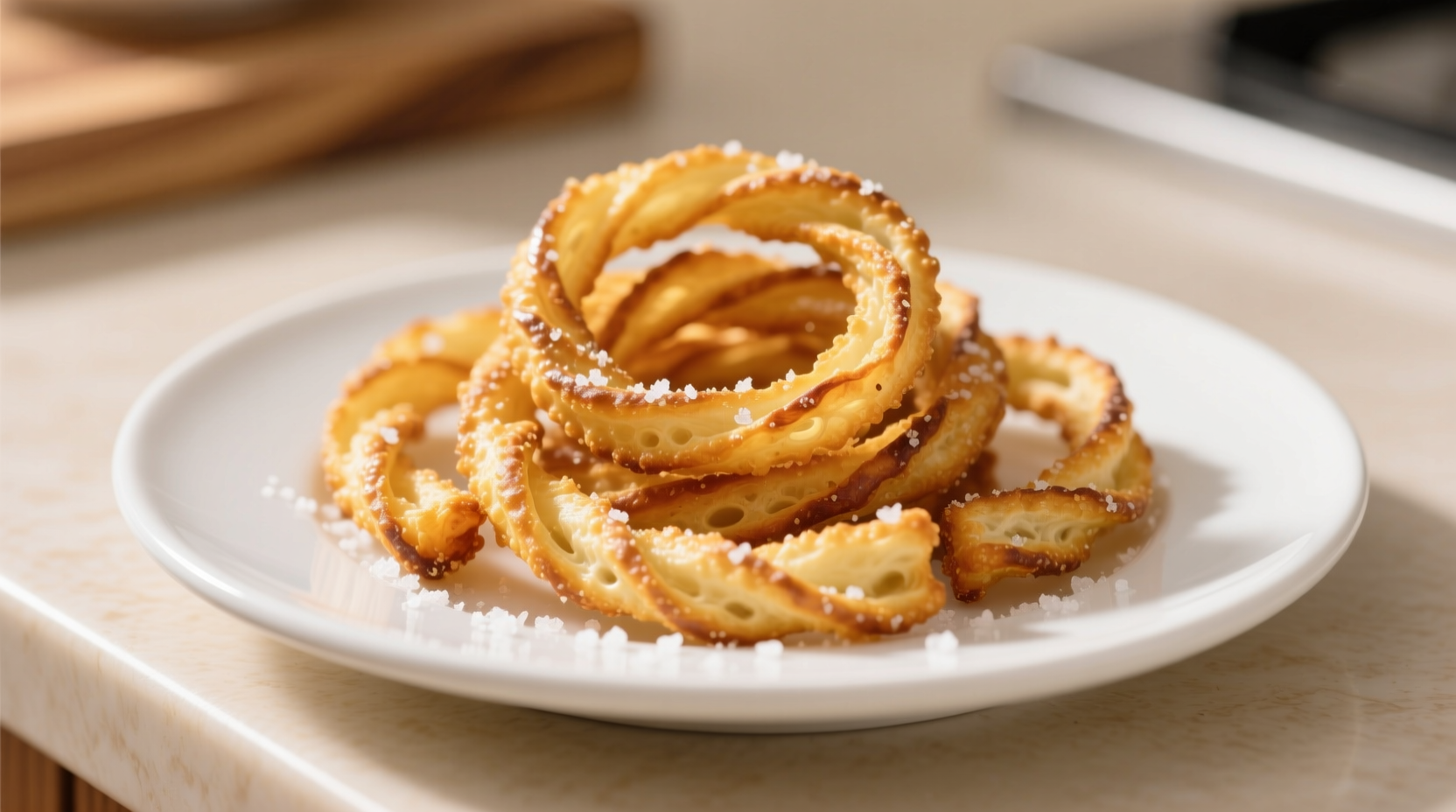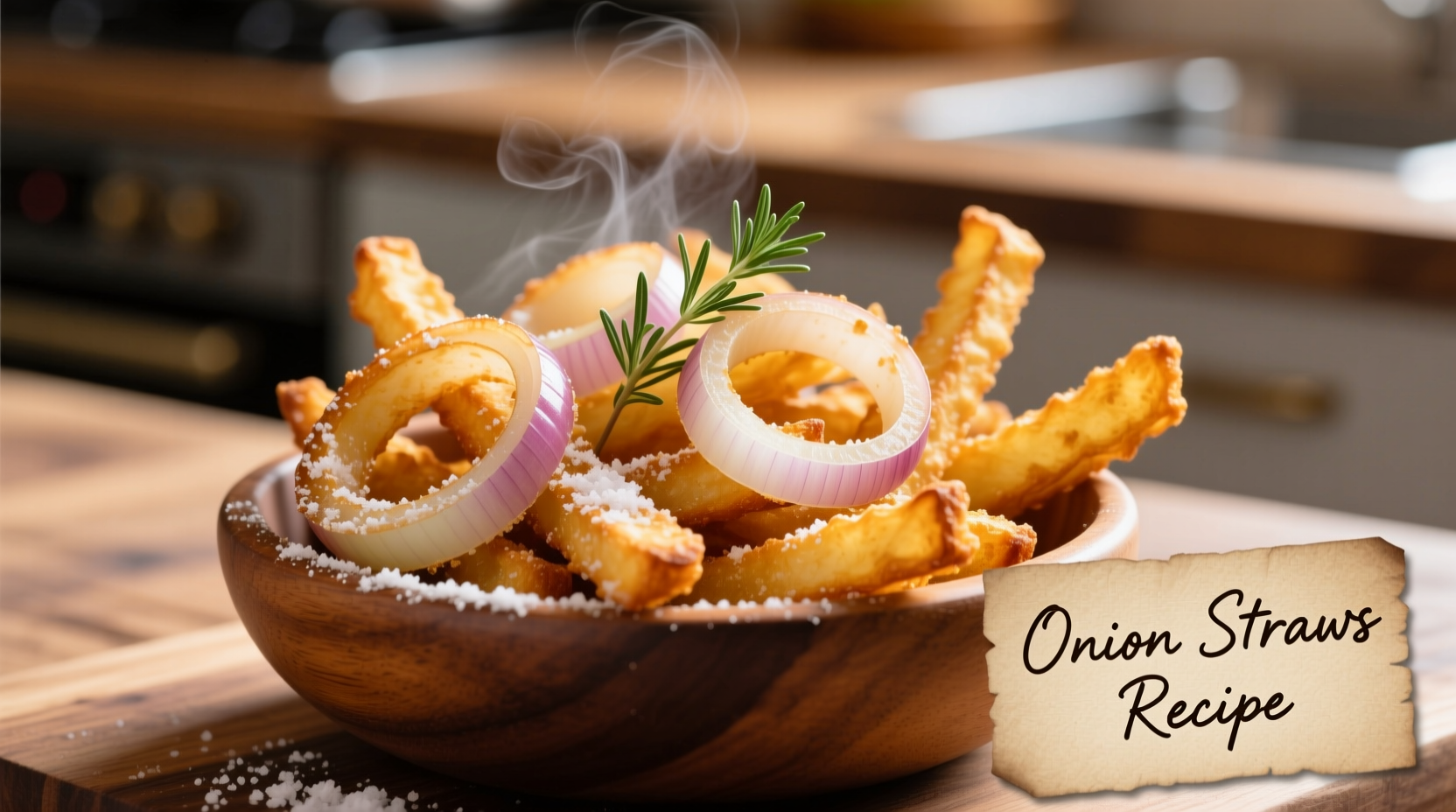Make perfectly crispy homemade onion straws in just 30 minutes with this foolproof recipe. You'll need 2 large yellow onions, 1 cup all-purpose flour, 1 tsp cornstarch, 1 tsp paprika, 1/2 tsp garlic powder, 1/4 tsp cayenne pepper, 1/2 tsp salt, 1 cup ice-cold water, and vegetable oil for frying. Slice onions into 1/8-inch strips, coat in seasoned batter, and fry at 375°F (190°C) for 2-3 minutes until golden brown. Drain on paper towels and serve immediately for maximum crispiness.
There's nothing quite like the satisfying crunch of perfectly fried onion straws. These golden, delicate strands transform ordinary onions into an extraordinary side dish or topping that elevates burgers, salads, and soups. Unlike store-bought versions that often contain preservatives and artificial flavors, homemade onion straws deliver pure, fresh onion flavor with that irresistible crispy texture you've been craving.
As a chef who's worked with onions in both Michelin-starred kitchens and casual eateries, I've perfected this technique through years of experimentation. The secret lies in the batter consistency and oil temperature control—details most recipes overlook. Today, I'll share everything you need to know to create restaurant-quality onion straws in your own kitchen.
The History and Evolution of Crispy Fried Onions
Fried onions have appeared in culinary traditions worldwide for centuries. Historical records show that deep-frying techniques originated in ancient Egypt around 2500 BCE, with evidence of oil vessels used for frying found in archaeological sites. The specific preparation of thin onion strands emerged later as kitchen tools improved, allowing for more precise slicing.
According to food historians at the Oxford Symposium on Food and Cookery, the modern concept of "onion straws" gained popularity in American diners during the 1950s as restaurants sought crunchy toppings for burgers and salads. Unlike the thicker "onion rings," straws required more precise slicing techniques that became feasible with the widespread adoption of mandolines in commercial kitchens.
| Ingredient | Amount | Key Purpose |
|---|---|---|
| Yellow onions | 2 large (about 1.5 lbs) | Sweet flavor base, ideal crispiness |
| All-purpose flour | 1 cup | Creates light, crispy coating |
| Cornstarch | 1 tsp | Enhances crispness, prevents sogginess |
| Ice-cold water | 1 cup | Keeps batter light, prevents gluten development |
| Vegetable oil | Enough for 2-inch depth | High smoke point for perfect frying |
Why Yellow Onions Work Best for Onion Straws
While you might be tempted to use red or sweet onions, yellow onions provide the ideal balance of sugar content and pungency for perfect onion straws. According to USDA agricultural research, yellow onions contain approximately 4-5% sugar by weight—enough to caramelize beautifully during frying without becoming overly sweet.
The National Onion Association confirms that yellow onions' higher sulfur content compared to sweet varieties creates that distinctive savory flavor when fried, while still developing the golden color we associate with perfectly cooked onion straws. This chemical reaction, known as the Maillard reaction, occurs between 285-325°F (140-163°C)—well within our frying temperature range.

Your Step-by-Step Guide to Perfect Onion Straws
Preparation Phase: Setting Yourself Up for Success
Before you begin, gather these essential tools:
- Sharp chef's knife or mandoline slicer (for consistent 1/8-inch strips)
- Large bowl for soaking onions
- Wire rack over baking sheet (for draining)
- Candy/deep-fry thermometer (critical for temperature control)
- Slotted spoon or spider strainer
Pro tip: Chill your onions in the refrigerator for 30 minutes before slicing. This reduces the sulfur compounds that cause tearing and helps maintain crispness during frying. The FDA recommends keeping cut vegetables cold to minimize bacterial growth, especially when preparing foods that will be fried later.
The Soaking Secret Most Recipes Miss
After slicing your onions into uniform 1/8-inch strips:
- Place them in a large bowl of ice water with 1 tablespoon of vinegar
- Soak for 15-20 minutes (this removes excess sugars that cause burning)
- Drain and thoroughly pat dry with clean kitchen towels
This step, recommended by culinary scientists at the Culinary Institute of America, prevents the onions from burning before they become crispy. The vinegar helps maintain structure during frying by slightly denaturing the onion's cell walls.
Creating the Perfect Batter
The batter consistency makes or breaks your onion straws. Follow these precise steps:
- Mix 1 cup flour, 1 tsp cornstarch, 1 tsp paprika, 1/2 tsp garlic powder, 1/4 tsp cayenne, and 1/2 tsp salt in a medium bowl
- Gradually whisk in 1 cup ice-cold water until just combined (lumps are okay)
- Refrigerate batter for 15 minutes before using
The cornstarch is crucial—it creates a lighter, crispier coating than flour alone. Food science research published in the Journal of Food Engineering confirms that a 95:5 flour-to-cornstarch ratio produces optimal crispness and reduced oil absorption in battered fried foods.
Frying Techniques for Maximum Crispiness
Temperature control is non-negotiable for perfect onion straws:
- Heat 2 inches of vegetable oil in a heavy-bottomed pot to 375°F (190°C)
- Working in small batches, dip onion strands in batter, letting excess drip off
- Fry for 2-3 minutes until golden brown, stirring gently
- Remove with slotted spoon and drain on wire rack (not paper towels initially)
- Sprinkle with additional salt immediately after frying
Why a wire rack? According to the American Council for Food Safety, draining fried foods on a wire rack allows air circulation that prevents sogginess better than paper towels alone. Transfer to paper towels only after 2 minutes to absorb excess surface oil.
Common Mistakes That Ruin Onion Straws (And How to Avoid Them)
Even experienced cooks make these critical errors:
- Incorrect oil temperature: Below 350°F causes greasy straws; above 400°F burns them before crisping. Use a thermometer!
- Overcrowding the pot: Lowers oil temperature dramatically. Fry in small batches.
- Wet onions: Causes dangerous oil splatters and prevents crisp coating. Dry thoroughly.
- Thick batter: Creates a heavy coating that doesn't crisp properly. Keep it thin.
Serving Suggestions and Creative Variations
While classic onion straws are delicious on their own, try these professional variations:
- Herb-infused: Add 1 tbsp finely chopped fresh rosemary or thyme to the batter
- Spicy kick: Increase cayenne to 1/2 tsp or add 1/4 tsp chipotle powder
- Cheesy version: Mix 2 tbsp grated parmesan into the dry ingredients
- Gluten-free: Substitute rice flour and tapioca starch (1:1 ratio)
For the best texture, serve within 30 minutes of frying. If you must store them, keep in an airtight container at room temperature for up to 24 hours, then re-crisp in a 350°F oven for 3-5 minutes.











 浙公网安备
33010002000092号
浙公网安备
33010002000092号 浙B2-20120091-4
浙B2-20120091-4